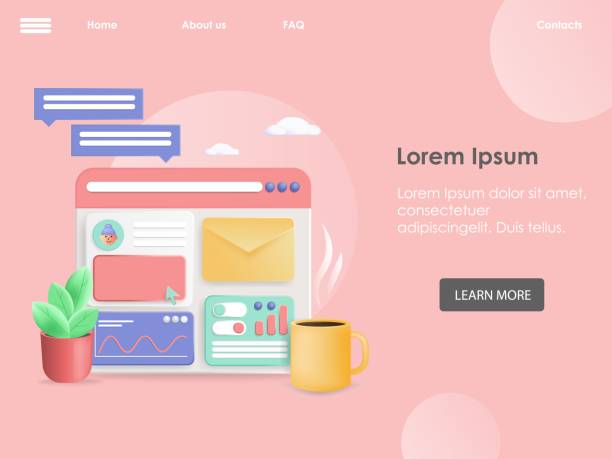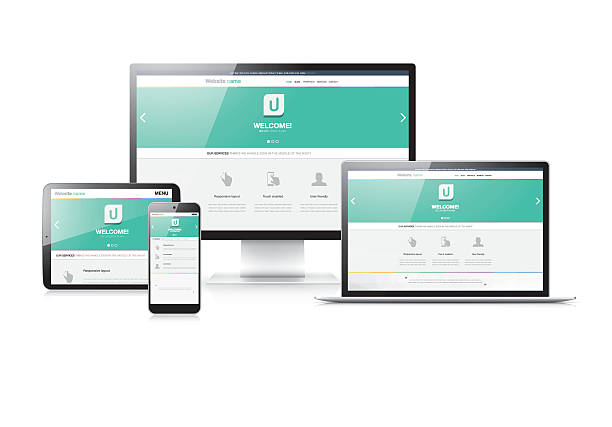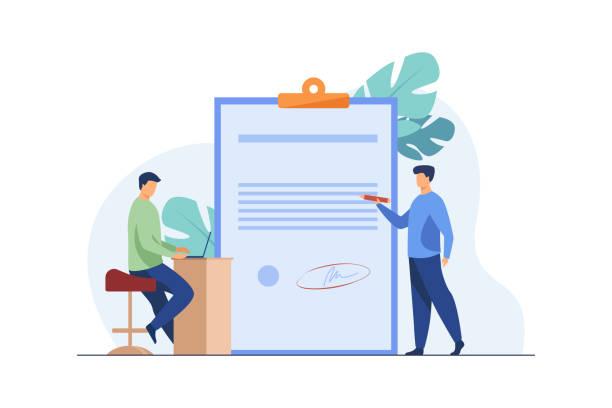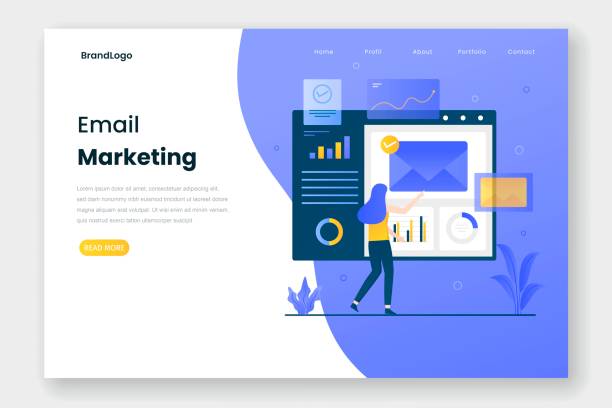Introduction to SEO-Optimized Website Design and Its Importance

In today’s digital world, an online presence is vital for any business.
But simply having a website is not enough; your website must be seen.
This is where the concept of SEO-optimized website design comes in.
Search Engine Optimization or SEO (Search Engine Optimization) is a process by which your website is designed and optimized to achieve a higher ranking in the search results of Google and other engines.
The main goal is to increase visits and attract organic and targeted traffic.
If you have a beautiful website but lack SEO principles, it’s like having a shop in the farthest part of town that no one knows about.
SEO is not just about using keywords, but includes a set of technical and content techniques that help search engines better understand your website and evaluate its value for users.
From proper user interface design to loading speed and site security, all play a role in SEO-optimized website design.
In this explanatory and educational section, we show you why investing in a website that adheres to SEO principles is a long-term and profitable strategy.
This is a complex but entirely learnable and implementable process that will bring significant results for your business over time.
Without SEO, a huge portion of your online business potential remains undiscovered.
How much does losing business leads due to an unprofessional website cost you? Solve this problem forever with a professional corporate website design by Rasawweb!
✅ Increase credibility and trust of potential customers
✅ Easier attraction of new business leads
⚡ Get a free consultation now!
Main Pillars of a Successful SEO-Optimized Website Design

To achieve an SEO-optimized website design, you need to be familiar with its main pillars.
These pillars go beyond just the visual aesthetics of a website and are more related to the underlying structure and the site’s comprehensibility by search engines.
One of the most important of these pillars is the correct selection and use of keywords, which we will discuss in detail in later chapters.
But beyond keywords, the logical structure of the site is also of paramount importance.
A website should have an organized information architecture that is easily navigable for both users and search engine bots.
This includes clear categories, understandable menus, and proper internal links.
Responsiveness or mobile compatibility is another vital pillar.
Given the significant increase in smartphone usage for internet access, Google prioritizes mobile-compatible websites.
This is an expert guide that every webmaster should pay attention to.
Website loading speed is also an important factor.
Today’s users are impatient and quickly leave slow sites; this high bounce rate sends a negative signal to search engines and lowers your site’s ranking.
Using optimized images, clean coding, and employing a CDN can help increase speed.
Finally, site security (HTTPS) is also one of the fundamental pillars.
Google prefers secure websites and gives them a better ranking.
These fundamental principles provide a strong framework for building an SEO-optimized website design and are essential for anyone looking to optimize their website.
The Role of Keywords in SEO-Optimized Website Design

At the heart of every SEO-optimized website design strategy lies intelligent keyword research and usage.
Keywords are the phrases users type into search engines to find the information, products, or services they need.
Choosing the right keywords not only brings more traffic to your site but also attracts targeted traffic with higher conversion potential.
This is an expert analysis that shows how to use keyword research tools like Google Keyword Planner, Ahrefs, or Semrush to identify highly searched and relevant phrases for your business.
You should look for keywords that have a decent search volume and where competition is not too high.
Also, the concept of Long-Tail Keywords is very important; these are multi-word phrases that indicate a more specific search and usually have less competition but bring higher conversion rates.
For example, instead of “website design”, “SEO-optimized website design for online clothing store” is a longer-tail keyword.
This helps search engines to identify your content more accurately and display it to more relevant users.
Targeting keywords in titles, meta descriptions, URLs, and body text is fundamental.
But be careful to avoid excessive keyword stuffing, as this is penalized by search engines and harms user experience.
This analytical approach helps you optimize your keyword strategy and pave the way for an SEO-optimized website design.
With a deep understanding of the User Intent behind each search, you can create content that precisely addresses their needs.
| Keyword Type | Description | Example |
|---|---|---|
| Short-tail Keywords | One or two words, high search volume, high competition, general search intent. | Website design, SEO |
| Long-tail Keywords | Three or more words, lower search volume, lower competition, specific search intent. | SEO-optimized website design training in Tehran, best website design company for e-commerce |
| LSI Keywords (Latent Semantic Indexing) | Semantically related words to the main keyword, help Google understand the content. | Content SEO, web optimization, Google ranking (for the word “website design”) |
Technical SEO for SEO-Optimized Websites

An SEO-optimized website design is not limited to good content; technical aspects also play a vital role.
Technical optimization refers to the process of preparing your website for better crawling and indexing by search engines.
This includes a set of actions that directly impact the technical performance of the site and are extremely important in the eyes of search engines.
Among the most important technical aspects is page loading speed.
A slow website can disrupt user experience and increase bounce rate, which harms SEO rankings.
Using image compression, optimizing CSS and JavaScript codes, and employing caching systems can significantly help improve speed.
The next topic is SEO-friendly URL structure.
Short, descriptive URLs that include relevant keywords are more understandable for both users and search engines.
Also, ensuring proper page indexability using robots.txt files and XML sitemaps is very important.
These tell search engines which pages to crawl and which to ignore.
Mobile optimization (Mobile-First Indexing) is another indispensable part of technical optimization, as Google primarily checks your site’s mobile version for indexing.
Removing duplicate content and managing redirects are also common technical errors that must be handled correctly.
These expert recommendations help you provide a strong technical foundation for your SEO-optimized website design and pave the way for achieving higher rankings in search results.
Did you know that 85% of customers check your company’s website before any interaction?
With Rasawweb, build a corporate website that befits your reputation.
✅ Increase customer credibility and trust
✅ Attract high-quality leads
⚡ Get a free website design consultation
Creating Engaging and SEO-Optimized Content

Content is king; this phrase never gets old in the world of SEO.
But for an SEO-optimized website design, simply producing content is not enough; the content must be engaging, valuable, and optimized.
Your content should answer users’ questions, address their needs, and provide unique information.
One important approach in this regard is creating educational content that helps users solve their problems or gain new knowledge.
For example, a comprehensive article on “How to design an SEO-optimized website?” can be very useful.
Question-provoking content can also increase user engagement.
Have you ever wondered why some websites, despite excellent content, don’t rank well? This is where the importance of content optimization for keywords and user intent becomes clear.
Search engines look for content that creates real value for the user and shows signs of E-E-A-T (Experience, Expertise, Authoritativeness, Trustworthiness).
This means your content should be written by experts and provide trustworthy information.
Using engaging titles, short paragraphs, lists, images, and videos can increase content readability and make it more appealing to users and search engines.
Regular updating of old content is also an important strategy; fresh content indicates site activity and sends positive signals to search engines.
This educational and thought-provoking section reminds you that the heart of any SEO-optimized website design is content that is not only understood by engines but also attracts users and converts them into customers.
User Experience (UX) and Its Impact on SEO

At first glance, User Experience (UX) might not seem directly related to SEO-optimized website design, but in reality, these two concepts are deeply intertwined.
Google and other search engines are increasingly paying attention to user experience signals when determining website rankings.
A website with excellent UX encourages users to spend more time on the site, visit more pages, and have a lower bounce rate.
These signals tell search engines that your site is valuable and useful, which can help improve your ranking.
Visually appealing design, easy navigation, and logical content layout are among the important UX factors.
Users should be able to easily find what they are looking for.
Loading speed, as mentioned earlier, is a key UX factor that directly impacts SEO.
Core Web Vitals, which include Largest Contentful Paint (LCP), First Input Delay (FID), and Cumulative Layout Shift (CLS), are Google’s metrics for measuring on-page user experience and directly impact SEO rankings.
This analysis explains how improving these metrics can help increase your site’s visibility.
Also, responsiveness and compatibility with various devices (mobile, tablet, desktop) are essential to provide a seamless experience for users.
Finally, paying attention to details such as readable fonts, appropriate color contrast, and user-friendly forms can make a big difference in user engagement rates.
Therefore, to have a successful SEO-optimized website design, the importance of user experience should never be underestimated.
Link Building and Site Authority in SEO-Optimized Design

Link Building is one of the main pillars of SEO-optimized website design that directly impacts your site’s credibility and authority in the eyes of search engines.
Backlinks, or links from other websites to yours, are considered “votes of confidence”.
The more high-quality links from reputable websites pointing to your site, the more credible and trustworthy search engines consider your site, and consequently, they will grant you a better ranking.
But not all links are equal; quality takes precedence over quantity.
High-quality links from relevant and authoritative sites are far more valuable than numerous links from spammy or irrelevant sites.
This is an expert guide that emphasizes the importance of a natural and ethical link-building strategy.
Buying links or participating in illegal link-building networks (Link Schemes) can lead to severe penalties from Google.
Correct link-building methods include creating valuable content that naturally attracts links, digital public relations and contacting relevant websites for content or link exchange, and using internal linking to improve navigation and distribute authority throughout the site.
Internal links help search engines better understand your site’s structure and identify more important pages.
Overall, a smart and continuous link-building strategy is an integral part of any SEO-optimized website design that seeks to increase authority and achieve stable rankings in search results.
By focusing on natural and high-quality links, you can help your website gain more visibility.
| Link Type | Description | Impact on SEO |
|---|---|---|
| DoFollow Link | Standard links that pass “authority” (Link Juice) to the destination page. | Positive: Helps increase site ranking and authority. |
| NoFollow Link | Links with the rel=”nofollow” attribute that tell search engines not to pass authority. | Neutral or Indirect: Does not directly affect ranking, but can generate traffic and brand awareness. |
| Sponsored Link | Paid links that should be marked with rel=”sponsored” for search engines to understand they are advertisements. | Informative: For transparency, if not specified, they may lead to penalties. |
| UGC Link (User Generated Content) | Links in user-generated content (like comments, forums) with rel=”ugc”. | Informative: For identifying user-submitted links and preventing abuse. |
Reviewing and Analyzing SEO-Optimized Website Performance

After implementing an SEO-optimized website design, your work is not over.
SEO is an ongoing process and requires continuous review and analysis.
This analytical section shows you how to evaluate your site’s performance and optimize your strategies based on data.
Tools such as Google Analytics and Google Search Console are among the most important sources of information.
Google Analytics allows you to track site traffic, user behavior, conversion rates, and traffic sources.
You can find out where users came from, how long they stayed on the site, and which pages are more popular.
Google Search Console also provides vital information about your site’s performance in search results, including the keywords users used to find you, the number of clicks and impressions, and any crawling or indexing issues.
Regularly reviewing these metrics helps you identify the strengths and weaknesses of your SEO strategy.
Is your bounce rate high? Perhaps you need to improve UX or content.
Are you ranking low for certain keywords? Perhaps you need to strengthen content optimization or link building.
Staying updated with Google algorithm news and updates is also of high importance.
Algorithms are constantly changing, and what is effective today might not be tomorrow.
This section helps you stay one step ahead with a news and analytical approach, keeping your SEO-optimized website design up to date.
Are you lagging behind in competition with large online stores?
Rasawweb, with professional e-commerce website design, brings your business online and increases your market share!
✅ Increase brand credibility and customer trust
✅ Easy shopping experience leading to more sales
⚡ Take action now for a free website design consultation!
Common Mistakes in SEO-Optimized Website Design and Solutions

On the path to SEO-optimized website design, there are common mistakes that can render your efforts fruitless and even lead to your site being penalized by search engines.
Understanding these mistakes and knowing their solutions is vital for any webmaster.
One of the biggest mistakes is ignoring keyword research.
Some websites produce content without investigating what users are truly searching for, which leads to a failure to attract traffic.
The solution is to always conduct in-depth keyword research before creating content.
Another mistake is failing to optimize for mobile.
Given Google’s mobile-first indexing priority, if your site is not displayed correctly on mobile, your ranking will be severely harmed.
The solution is responsive design and continuous testing of site performance on various devices.
Slow site speed is also a killer for SEO and user experience.
Don’t forget that unoptimized images, heavy code, and poor hosting can severely reduce speed.
Optimizing images, compressing codes, and using powerful hosting are among the solutions.
Using duplicate or low-value content is also something Google is sensitive to.
Always produce unique, high-quality, and valuable content.
Finally, unnatural and spammy link-building can lead to manual penalties.
Instead of buying links, focus on producing excellent content and digital PR.
This educational and guidance section prevents you from falling into the trap of these common mistakes in SEO-optimized website design and helps you to follow the correct path for your online success.
The Future of SEO-Optimized Website Design and Emerging Trends

The world of SEO-optimized website design never stands still and is constantly evolving.
What is considered a top strategy today may become obsolete tomorrow with the emergence of new technologies and changes in user behavior.
This section explores emerging trends and the future of SEO, and has a somewhat entertaining and predictive aspect.
One of the most important current and future trends is the increasing importance of Artificial Intelligence (AI) and Machine Learning in Google’s algorithms.
Systems like RankBrain and MUM enable Google to understand the intent behind more complex searches and deliver more relevant results.
This means content must focus more than ever on addressing user intent and providing comprehensive information.
Voice Search is also growing, with more users employing voice assistants for searching.
This increases the need to optimize content for conversational and question-based search phrases.
Also, Local SEO has become more important for physical businesses, as many voice and mobile searches have local intent.
Video SEO has also become an important factor, given the popularity of platforms like YouTube and TikTok.
Optimizing video titles, descriptions, and tags for search engines provides a new opportunity for visibility.
Finally, Immersive UX using Augmented Reality (AR) and Virtual Reality (VR) may play a more prominent role in SEO in the future.
For any SEO-optimized website design, the key to success is flexibility, staying up-to-date with these changes, and continuously adapting strategies.
The future of SEO is full of exciting challenges and opportunities.
Frequently Asked Questions
| Question | Answer |
|---|---|
| What is SEO-optimized website design? | SEO-optimized website design means creating a website that is not only attractive and user-friendly for users but also has its structure and content optimized for search engines (like Google) to achieve a higher ranking in search results. |
| Why is SEO-optimized website design important? | SEO-optimized website design increases your website’s visibility in search engines, attracts more organic (free) traffic, boosts your brand’s credibility and trust, and ultimately leads to increased sales and customers. |
| What are the key factors in SEO-optimized website design? | Key factors include website loading speed, responsiveness (mobile compatibility), appropriate URL structure, correct use of title and description tags (Meta Title & Description), image optimization, high-quality and user-friendly content, and internal and external link building. |
| What is the role of content in website SEO? | Content is king. High-quality, unique, relevant, and up-to-date content that naturally incorporates target keywords plays a crucial role in attracting users and sending positive signals to search engines. |
| What impact does website speed have on SEO? | Website speed is one of Google’s important ranking factors. Slow sites offer a poor user experience and can lead to an increased bounce rate, which harms your SEO ranking. |
| What does website responsiveness mean and why is it important for SEO? | Responsiveness means that your website is displayed correctly on any device (mobile, tablet, laptop). Since most searches are conducted via mobile, Google prioritizes responsive sites. |
| How do we choose appropriate keywords for a website? | Choosing appropriate keywords is done by researching and analyzing user and competitor needs. Using tools like Google Keyword Planner, Ahrefs, or Semrush can help in finding high-volume and relevant keywords. |
| What is the importance of internal and external link building in SEO? | Internal link building helps improve site navigation, distribute Page Authority, and assist search engine crawling. External links (backlinks) from reputable sites also serve as a sign of your website’s authority and expertise for Google. |
| What is the role of User Experience (UX) in SEO? | Good user experience means ease of use, visual appeal, and user satisfaction with the site. Good UX encourages users to stay on the site longer and interact more, which are considered positive signals for SEO ranking. |
| What tools are available for website SEO analysis? | There are numerous tools for SEO analysis, including Google Search Console for examining site performance in search, Google Analytics for traffic analysis, GTmetrix and PageSpeed Insights for speed assessment, and paid tools like Ahrefs and Semrush for comprehensive SEO and competitor analysis. |
And other advertising services from Rasawweb Advertising Agency
Smart Conversion Rate Optimization: Designed for businesses seeking to improve SEO rankings through precise audience targeting.
Smart Link Building: A professional solution for customer behavior analysis focusing on Google Ads management.
Smart Website Development: A professional solution for online growth focusing on SEO-driven content strategy.
Smart Advertising Campaign: A professional solution for customer behavior analysis focusing on intelligent data analysis.
Smart Digital Advertising: An innovative service to enhance customer behavior analysis through key page optimization.
And over hundreds of other services in the field of internet advertising, advertising consulting, and organizational solutions
Internet Advertising | Advertising Strategy | Advertorial
Resources
Importance of SEO-Optimized Website DesignComprehensive Guide to SEO-Oriented Website DesignSEO Principles for BeginnersKey Tips for Website SEO
Rasawweb Afarin Digital Marketing Agency is your partner on the path to achieving digital success peaks. With services such as modern UI website design, professional SEO, social media management, and content marketing, we transform your business.
📍 Tehran, Mirdamad Street, next to the Central Bank, South Kazeroon Alley, Ramin Alley, No. 6



